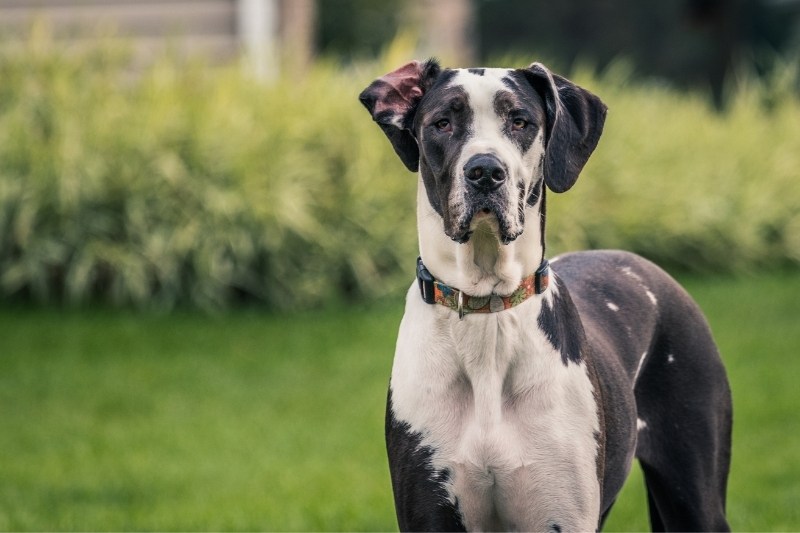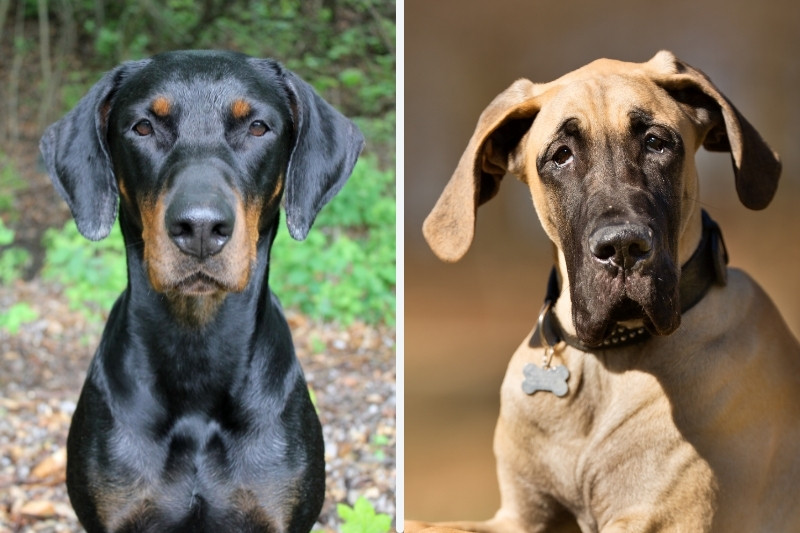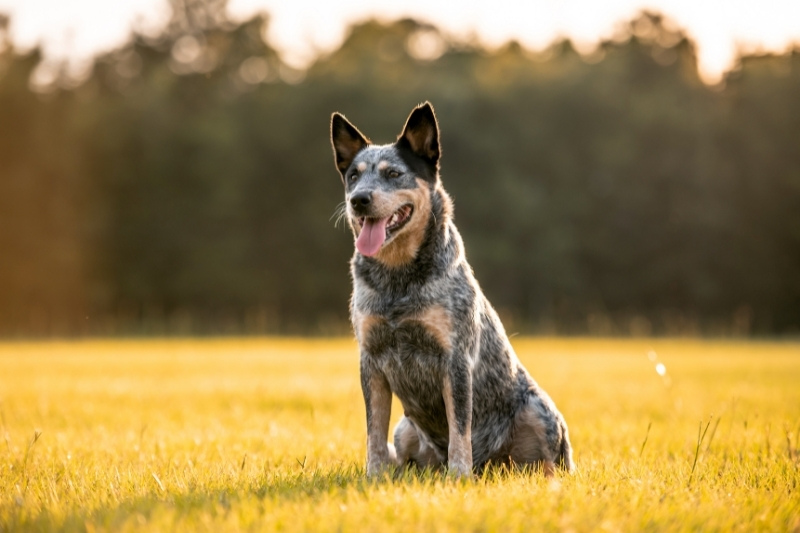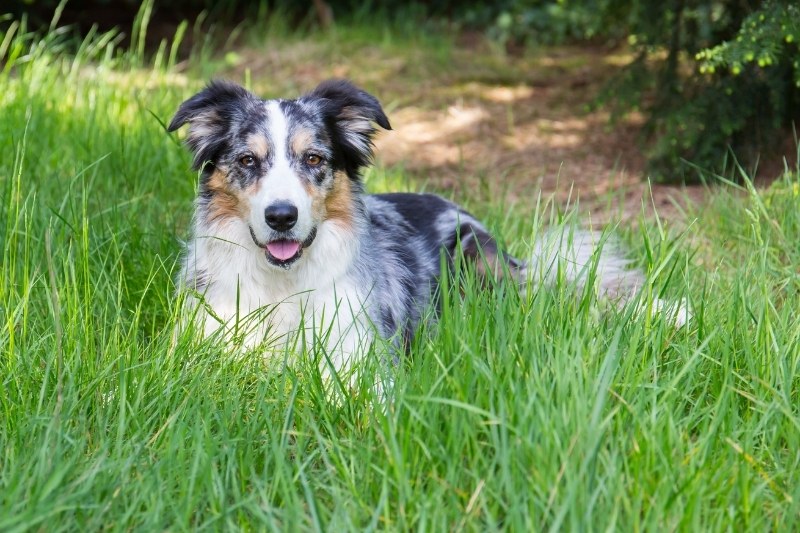All the Great Dane colors (with pictures!)

At a height of 32 inches and a weight of 175 pounds, you can hardly miss a Great Dane when you cross one.
And although some may find these large dogs intimidating they actually have the nickname ‘gentle giants'. These dogs are elegant, calm, and surprisingly friendly. Something else that attracts many dog owners to these pups is all the Great Dane colors.
These dogs come in a number of different colors and patterns and there really is a big, gentle giant for everyone. There are, however, a couple of things to consider before adopting one of these impressive pooches.
Which Great Dane colors does the AKC accept?
Although there are nearly 20 different Great Dane colors and patterns, the American Kennel Club only accepts 10 of them as a breed standard. Although this might not be important to many potential owners, it's something to think about if you want to enter your dog into a competition.
The AKC recognizes the following official Great Dane colors:
- Black
- Black and white
- Blue
- Brindle
- Fawn
- Harlequin
- Merle
- Silver
- White
- Mantle
What to think about before adopting a Great Dane?
There are a couple of things to be aware of before you set your heart on a Great Dane. The first is that these big dogs have a relatively short lifespan. In general, the larger the dog the shorter the time you'll have with them. They can also suffer from a few health issues such as gastric dilatation-volvulus.
What's more, these dogs aren't easy for novice owners. Even though Great Danes are gentle and loving pups, their sheer size can be difficult to deal with. They can also be a bit clumsy! It's crucial they're trained well to avoid any possible problems from arising.
When adopting any dog, it's important you don't just concentrate on color. Of course, you may love a blue Great Dane, a merle Great Dane, or a Harlequin Great Dane but health and temperament are the most important factors. Just because your pup has a beautiful coat color doesn't mean that they're a healthy dog that will get along well with your family.
The possible coat colors for Great Danes
All of these 10 possible Great Dane colors are beautiful (especially when paired with their impressive bodies)! Which one will be your favorite?
Black Great Dane
Black Great Danes are particularly striking (and a little intimidating). For a Great Dane to be considered black, they shouldn't have any other markings on their coat. This includes white patches on their chest or toes. A healthy black Great Dane coat should be shiny and highlight its muscular frame.
Genetically, two black Great Danes or two Great Danes with the black gene have to be selectively bred to get this coat color. The gene is recessive and therefore this combination is rare.
Black and White Great Dane

These Great Danes have a predominately black coat color and can have white markings on their chest and paws. The majority of the coat should be black though.
This coloring is a fairly common combination for Great Danes and is sometimes confused with Mantle and Harlequin Great Dane colors (more on those in a bit)!
Blue Great Dane
Blue Great Danes are really beautiful dogs and fairly rare. Their coat is a less-intensely colored black coat that has an attractive blue/gray look. Just like black dogs, white patches or markings of any other kind are not desired.
The blue gene is a recessive gene and both parent Great Danes need to be black or blue and have the blue gene. The pure steel blue color of these wonderful pups can be fairly light or dark but one thing's for sure – they'll be very attractive!
Brindle Great Dane
Brindle Great Danes look a little like tigers. The AKC accepts this color with a fawn or light brown base coat and black, tiger-like stripes. They may have a black mask or darker markings on their face. It's also possible that these brindle dogs come in blue brindle (which is also very pretty) but these pooches are not accepted.
This coat color is possible when a fawn Great Dane is bred with another fawn Great Dane or with a brindle pup.
Fawn Great Dane
Fawn is definitely the most common Great Dane color. The beautiful, light brown/tan color should cover all of their body (although a black mask is allowed and a different colored tail tip). Any other colorings or markings are enough for these doggos to be disqualified from competitions.
Even though they're a common color for the Great Dane breed, fawn is actually a recessive gene. This means both pup parents must be fawn to produce a Great Dane puppy with this coloring.
Harlequin Great Dane
As we already mentioned, harlequin Great Danes are beautiful black and white pups. But not like ‘regular' black and white Great Danes. These doggos have a beautiful white coat with spots and splodges of black all over them. They almost look like they've had paintbrushes spattered on them! What's more, each harlequin Great Dane has a totally unique coat with a unique pattern.
If you've ever seen a Great Dane with this coat color then you'll know they're a real show stopper. But actually, it's incredibly hard to enter these doggos into a show or competition.
In order to be considered a breed standard, these Great Danes must have a pure white neck (with no black markings) and there can't be a large black marking on them that covers too much of their body.
Merle Great Dane

Merle Great Danes have only recently been officially recognized by the AKC (in 2018). These beautiful, mottled coated dogs are fairly similar to harlequin Great Danes except their base color is usually gray. This means their spots can be either black or white.
These dogs can be pure Merles (both parents are merle) or Merlequin (one parent is merle and the other harlequin). Although very attractive, there's quite a lot of controversy around breeding merle dogs in general.
A well-bred merle with a single merle gene can be as healthy as a non-merle but double merle puppies or ones that haven't been ethically bred can have serious health concerns. These include ear and eye problems.
Silver Great Dane
Do you have pictures of a Silver Great Dane? Send it to us and we’ll feature you!
The silver Great Dane is very similar to the blue Great Dane – in terms of both appearance and genetics. Like the blue gene, the silver gene waters down a black coat coloring to give it a lighter and less intense appearance. These dogs aren't actually silver and shiny, but their coats can be a pale or dull gray. They're certainly very beautiful and eye-catching dogs!
White Great Dane
White Great Danes are fairly rare and are sure to turn some heads.
But in fact, the Great Dane Club of America warns against breeding dogs with this coat color. That's because, in order to get a white coat, both parent dogs have to carry the merle gene.
This can result in a white dog that is double merle – meaning they could suffer from deafness or other conditions associated with the gene.
Mantle Great Dane
Mantle Great Danes are the third on the list that have a coat that's made up of black and white patches. Unlike black and white Great Danes or harlequin Great Danes, these doggos don't have any spots or splodging.
Instead, their beautiful coats are made up of solid blocks of color. Black is the predominant color with white patches on their chest, face, and front legs.
Are there other coat color possibilities?
Yes! The Great Dane breed can come in a mixture of many different coat colors. The above are just the common ones and the ones accepted by the AKC.
Other colors include chocolate, chocolate and white, piebald, blue and white, and fawnequin.
FAQs
Does a Great Dane's coat color affect its health?
Yes. There are some coat colors that can cause more health conditions than others. White and merle, for example, can be problematic. Dogs with this coloring may suffer from deafness and eye conditions.
Generally, however, as long as your pup is responsibly bred and you take them for regular check-ups (and they don't have a double merle gene) then they should be healthy.
Can Great Dane colors change over time?
Yes! It's possible that your dog's coat color could change over time. In fact, you should really wait until your pup is fully mature before entering them into competition (you wouldn't want them to look different a few months later)!
It's quite common with light-colored dogs (such as fawn) that their coat gets darker. Once they shed their fluffier puppy coat, their new mature coat may be a slightly darker color.
Does it really matter what color you get?
That really depends on you and whether you want to enter them into a show or not. For obvious reasons, we don't recommend getting a pup whose coat could give them possible health problems.
A coat color won't affect your dog's behavior or temperament – and these are much more important factors than what they look like. Go for a Great Dane that's been well-bred and that has all the certifications necessary.
What color eyes do Great Danes have?
Great Danes can have a number of different eye colors, some of which depend on their coat color. They can have brown, green, amber, gray, and blue eyes. Most Great Danes have blue eyes when they're born but only harlequin Great Danes may keep them. They can also have different colored eyes.
Conclusion
These beautiful, majestic, and gentle dogs come in 10 colors recognized by the AKC. They can, however, be a mix of many of them. They vary between bright white and jet black – and everything in between!
For experienced owners who can handle the size of these large dogs, they make wonderful family pups who will love you forever!
I’m Charlotte, a content and copywriter from the North of England and currently living in Berlin. Animals have always been a huge part of my life, so writing about dogs is a total pleasure! I love all kinds of dogs and their cheeky personalities, but I’d have to say Weimaraners are my favourite!








